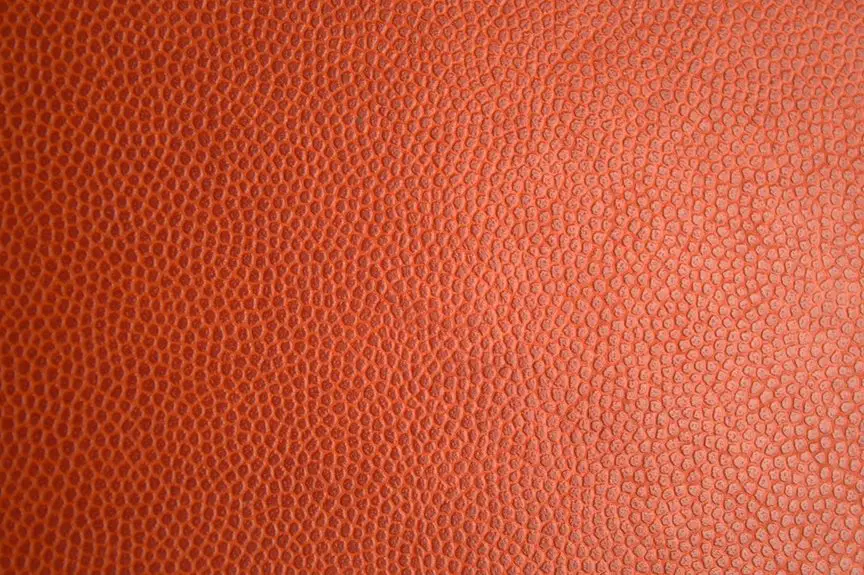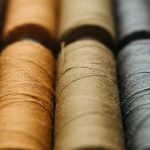Polypropylene upholstery fabric is a lightweight, durable synthetic fiber made from propylene gas. You’ll appreciate its stain, moisture, and fade resistance—perfect for busy homes or commercial use. It dries quickly, resists pilling, and is easy to maintain, though it’s sensitive to heat and sunlight. While eco concerns exist, its affordability and durability make it a smart choice. Keep going to explore care tips, best uses, and what to take into account before buying.
Table of Contents
Key Takeaways
- Polypropylene upholstery is a lightweight, durable synthetic fabric made from polymerized propylene, resistant to moisture and stains.
- It offers excellent stain resistance, quick drying, and durability, making it ideal for high-traffic and outdoor furniture.
- The fabric is cost-effective, easy to maintain, and resists pilling, abrasion, fading, and static buildup.
- Drawbacks include sensitivity to heat, potential color fading in sunlight, and environmental concerns due to non-biodegradability.
- For care, vacuum regularly, spot clean with mild soap, avoid bleach, and choose UV-resistant options for sun-exposed furniture.
What Is Polypropylene Fabric Made Of?
Polypropylene fabric is made from a thermoplastic polymer derived from propylene gas. When you look at it closely, you’ll find it’s a synthetic fiber created through polymerization, turning propylene molecules into long chains.
This process results in a lightweight, durable material with excellent resistance to moisture and stains. Because it’s a thermoplastic, polypropylene melts when heated and solidifies upon cooling, allowing manufacturers to mold it into various forms.
You’ll often find this fabric blended with other fibers or used on its own for upholstery due to its strength and resilience. Understanding its chemical makeup helps you appreciate why it resists mold, mildew, and fading better than many natural fabrics, making it a smart choice for furniture that needs to stay fresh and sturdy over time.
Key Features of Polypropylene Upholstery
When choosing upholstery fabric, you’ll want to focus on the qualities that make it stand out in durability and maintenance.
Polypropylene upholstery offers excellent resistance to stains, moisture, and fading, making it a practical choice for busy households. It’s lightweight yet strong, so it holds up well under regular use without stretching or tearing easily.
Polypropylene upholstery is stain-resistant, durable, and perfect for busy homes, combining strength with lightweight comfort.
The fabric also resists pilling and abrasion, maintaining a smooth surface over time. Because polypropylene doesn’t absorb water, it dries quickly, reducing the risk of mold or mildew.
Additionally, it resists static, which helps repel dust and pet hair. With its colorfastness and easy-clean properties, polypropylene upholstery combines functionality with convenience, ensuring your furniture stays looking fresh with minimal effort.
Advantages of Using Polypropylene for Furniture
You’ll appreciate how polypropylene stands out for its durability and strength, making your furniture last longer.
It’s also great at resisting stains and water, so spills won’t ruin your pieces.
Plus, it’s cost-effective and easy to maintain, saving you time and money in the long run.
Durability and Strength
Toughness plays a key role in choosing the right fabric for your furniture.
Polypropylene stands out because it’s incredibly durable and strong, making it perfect for high-traffic areas. You won’t have to worry about the fabric wearing out quickly, even with daily use. It resists abrasion well, so it holds up against scratches and rubbing.
Plus, polypropylene’s strength means it can support weight and tension without stretching or tearing. If you have kids or pets, this fabric will endure their active lifestyle without losing its shape or integrity.
When you pick polypropylene upholstery, you’re investing in a fabric that maintains its look and performance over time, saving you from frequent replacements or repairs. It’s a smart choice if durability matters to you.
Stain and Water Resistance
Although spills and stains are inevitable, polypropylene fabric makes cleanup easy thanks to its excellent stain and water resistance.
When you use furniture upholstered with polypropylene, liquids bead up on the surface instead of soaking in, giving you more time to wipe them away. This fabric resists common household stains like coffee, wine, and juice, so you won’t have to worry about permanent marks ruining your furniture.
Its water-resistant properties also help prevent mold and mildew growth, which is especially useful if you live in a humid area or have pets.
Cost-Effectiveness and Maintenance
Thanks to its stain and water resistance, polypropylene fabric helps you avoid costly repairs or replacements caused by damage. You’ll save money over time because this material resists spills and dirt, reducing the need for professional cleaning or frequent maintenance.
Polypropylene is also durable, so it stands up well to everyday wear and tear, meaning your furniture stays looking fresh longer. Cleaning is simple—you can usually spot clean with mild soap and water without worrying about fading or shrinking.
Since it dries quickly, maintenance fits easily into your routine. Choosing polypropylene upholstery means you get a budget-friendly option without sacrificing quality or appearance, making it a smart investment for busy households or commercial spaces.
Common Drawbacks of Polypropylene Upholstery
While polypropylene offers many benefits, you should be aware of some drawbacks before choosing it for your furniture.
It can fade in bright sunlight, isn’t great with heat, and raises some environmental concerns.
Understanding these issues will help you make a smarter decision for your upholstery needs.
Color Fading Issues
When you choose polypropylene upholstery, you might notice its colors start to fade faster than other fabrics. This happens because polypropylene fibers don’t hold dyes as well, especially when exposed to sunlight.
Over time, the vibrant hues can dull, affecting your furniture’s appearance. To manage color fading, consider these tips:
- Place upholstery away from direct sunlight to slow fading
- Use UV-protective window treatments or films
- Rotate cushions regularly to even out wear and sun exposure
- Clean gently with mild detergents to avoid stripping color
Heat Sensitivity Concerns
Because polypropylene fibers are sensitive to heat, you’ll need to be cautious about where and how you use this upholstery fabric. High temperatures can cause the fibers to melt or deform, which means placing polypropylene upholstery near heat sources like radiators, fireplaces, or direct sunlight for extended periods isn’t a great idea.
When cleaning, avoid using hot water or heat-based drying methods, as these can weaken the fabric or cause shrinkage. Also, ironing polypropylene upholstery is generally off-limits since the heat can damage its structure.
If you’re selecting upholstery for a high-traffic or sunny area, consider how heat sensitivity might affect durability and appearance over time. Being mindful of these factors will help you maintain your polypropylene fabric’s quality and lifespan.
Environmental Impact Considerations
Though polypropylene upholstery offers durability and affordability, it comes with environmental drawbacks you should consider.
This synthetic fabric is derived from non-renewable fossil fuels, which contributes to resource depletion. Additionally, its production releases greenhouse gases, impacting climate change.
When discarded, polypropylene doesn’t biodegrade easily, leading to long-term landfill waste. Recycling options are limited, so most ends up as persistent plastic pollution.
Here’s what you should keep in mind:
- Made from petroleum-based materials
- High carbon footprint during manufacturing
- Non-biodegradable, persisting in landfills
- Limited recycling infrastructure available
If minimizing your environmental impact matters, weigh these factors before choosing polypropylene upholstery for your furniture.
Comparing Polypropylene to Other Upholstery Fabrics
If you’re choosing upholstery fabric, understanding how polypropylene stacks up against other materials can help you make the best decision for your needs. Polypropylene stands out for durability and stain resistance, but other fabrics also have unique benefits. Here’s a quick comparison:
| Fabric | Durability | Maintenance |
|---|---|---|
| Polypropylene | High (resists wear) | Easy (stain-resistant) |
| Cotton | Moderate (wears faster) | Moderate (can stain) |
| Leather | High (ages well) | Requires conditioning |
| Wool | Moderate (pills) | Needs gentle care |
You’ll notice polypropylene excels in durability and low maintenance, perfect if you want long-lasting, easy-care fabric. However, if you prefer natural fibers or luxury feel, cotton, leather, or wool might suit you better.
Best Uses for Polypropylene Upholstery Fabric
When you need upholstery that can handle heavy use without losing its look, polypropylene fabric is an excellent choice. Its durability and resistance to stains make it perfect for areas where wear and tear are common.
You’ll find polypropylene works well in various settings, including:
- Family rooms where kids and pets play frequently
- Outdoor furniture exposed to sunlight and moisture
- Commercial spaces like waiting rooms and offices
- High-traffic dining chairs prone to spills
How to Care for and Clean Polypropylene Upholstery
Polypropylene upholstery stands up well to daily wear, but keeping it looking fresh means regular care and proper cleaning.
Start by vacuuming your furniture weekly to remove dust and debris. For spills, blot immediately with a clean cloth—avoid rubbing, which can push stains deeper.
Use mild soap mixed with lukewarm water for spot cleaning; apply gently with a soft cloth and rinse with plain water. Avoid harsh chemicals or bleach, as they can damage the fibers.
For tougher stains, a diluted vinegar solution works well, but always test in an inconspicuous area first. Let the fabric air dry completely to prevent mildew.
With these simple steps, you’ll maintain your polypropylene upholstery’s durability and vibrant appearance over time.
Environmental Impact of Polypropylene Fabric
Though durable and affordable, this fabric has notable environmental considerations you should be aware of.
Durable and budget-friendly, yet it carries important environmental impacts worth considering.
Polypropylene is a synthetic material derived from petroleum, which means its production relies on fossil fuels. When you choose this fabric, keep in mind:
- It’s not biodegradable, so it can persist in landfills for years.
- Production emits greenhouse gases contributing to climate change.
- Recycling options are limited, though some facilities accept it.
- It requires less water and energy during manufacture compared to natural fibers.
Tips for Choosing the Right Polypropylene Upholstery
How do you find the perfect polypropylene upholstery fabric for your needs? Start by considering the fabric’s durability—look for a high double rub count to guarantee it withstands daily use.
Next, check for stain resistance, especially if you have kids or pets. You’ll want a fabric that’s easy to clean and maintain.
Also, think about the color and texture; polypropylene offers many options, so pick one that complements your space.
Don’t forget to verify if the fabric is treated for UV resistance if your furniture sits near windows.
Finally, assess your budget, balancing quality with cost. By focusing on these factors, you’ll choose polypropylene upholstery that’s not only stylish but also practical and long-lasting.
Frequently Asked Questions
Can Polypropylene Upholstery Fabric Be Recycled at Home?
You won’t find a Victorian-era recycling bin for polypropylene upholstery fabric at home, but you can still recycle it. Just check local facilities accepting polypropylene, then clean and sort your fabric for proper recycling.
Is Polypropylene Upholstery Safe for People With Allergies?
You’ll find polypropylene upholstery generally safe for allergy sufferers because it resists dust mites and mold. However, if you have severe sensitivities, it’s smart to test a small area or consult an allergist before buying.
How Long Does Polypropylene Upholstery Typically Last?
You can expect polypropylene upholstery to last around 10 to 15 years with proper care. Imagine your favorite chair still looking vibrant after a decade—polypropylene’s durability makes that possible, resisting wear and stains effectively.
Does Polypropylene Upholstery Fade in Direct Sunlight?
Yes, polypropylene upholstery can fade in direct sunlight over time. To keep your furniture looking fresh, you should avoid prolonged exposure or use window treatments and UV-protective sprays to minimize fading and damage.
Can Polypropylene Upholstery Be Used Outdoors Year-Round?
Since polypropylene withstands weather well, you can confidently choose it for continuous, year-round outdoor use. Just remember to routinely rinse and remove dirt to maintain its vibrant, durable look despite sun and storms.
- Hero Fabric Spray and Kevlar: Myths About Disabling Body Armor - June 21, 2025
- Heavyweight Kevlar Protective Fleece: Soft Armor Solutions - June 21, 2025
- Gray Kevlar Fabric: Industrial and Tactical Applications - June 21, 2025







